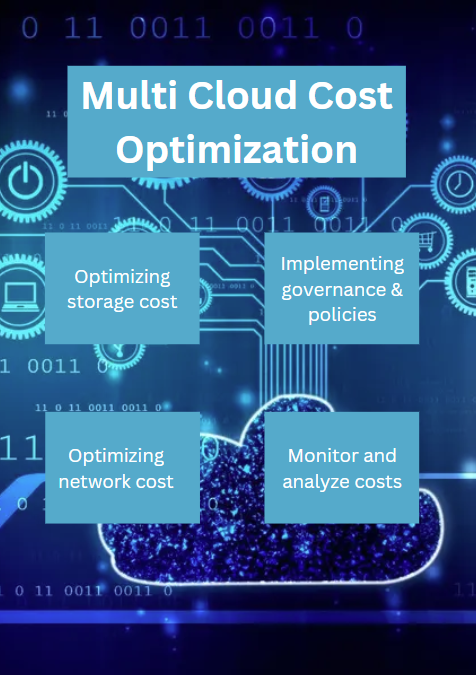In this final part of our series on strategic cost optimization techniques in multicloud deployments, we explore methods for optimizing storage costs, implementing governance and policies, and managing network costs. Each section provides detailed explanations on why these techniques are important, how they impact costs, and best practices for implementation.

Optimizing storage costs
Effective storage optimization is crucial for managing one of the largest components of cloud expenses. Properly managing storage costs helps avoid unnecessary spending and ensures efficient data management. By utilizing storage tiers and data lifecycle policies, you can reduce costs associated with data storage and improve cost efficiency. For example, Oracle Cloud Infrastructure (OCI) storage tiers allow you to use Standard, Infrequent Access, and Archive tiers based on data access patterns. Amazon Web Services (AWS) S3 Intelligent Tiering automatically moves data between access tiers, while Azure Blob Storage Tiers utilize hot, cool, and archive tiers for data based on access needs. Consider a scenario where you archive infrequently accessed backups to OCI Archive Storage, resulting in significant cost savings. This approach reduces storage costs while maintaining necessary data availability and performance.
Implementing governance and policies
Governance and policy frameworks ensure effective cost management and prevent cost overruns. They help maintain control over cloud expenses and enforce best practices. Implementing governance policies helps manage resources effectively, enforce cost-saving measures, and ensure compliance, leading to optimized spending. For example, you can use OCI Governance Tools, AWS Organizations, and Azure Policy to enforce standards and compliance for resources. A use case might involve using OCI’s tagging for cost allocation by department and creating roles in Identity and Access Management (IAM0 for different cost management responsibilities. This setup ensures budget adherence, improves cost visibility, and enhances resource management practices.
Optimizing network costs
Network costs can significantly impact your cloud spending, especially when dealing with large-scale data transfers or inefficient network configurations. Effective network optimization helps manage these costs, while ensuring that you meet performance and reliability requirements. Optimizing network costs can lead to substantial savings by minimizing fees associated with data movement, improving network efficiency, and reducing the need for expensive high-bandwidth options. For instance, OCI Edge Services like OCI FastConnect provide a dedicated, private connection that reduces data transfer costs and improves performance. AWS CloudFront and Azure CDN offer similar benefits for content delivery.
Network optimization tools, such as OCI Traffic Management Steering Policies and AWS VPC traffic mirroring, can further enhance network performance and cost efficiency. Data transfer solutions like OCI Data Transfer aervice, AWS S3 Transfer Acceleration, and Azure Data Box can help manage large data movements efficiently. A global e-commerce company might use OCI FastConnect for a direct, high-bandwidth connection to improve content delivery and reduce data transfer costs. This approach balances costs across multiple cloud providers to achieve the most efficient network setup.
Monitor and analyze costs continuously
Continuous cost monitoring and analysis are essential for maintaining budget control and identifying optimization opportunities. Ongoing reviews, real-time alerts, and detailed reporting help track expenses, prevent budget overruns, and discover cost-saving opportunities. Regular cost reviews, real-time alerts, and reporting and visualization tools can help achieve this goal. For example, a technology company might set up real-time alerts and cost management dashboards to stay within budget and identify optimization opportunities. This proactive approach improves cost management through continuous monitoring and analysis, ensuring budget adherence and uncovering cost-saving opportunities.
Optimize licensing and subscription plans
Licensing and subscription plans can be a significant expense in cloud environments. Optimizing these plans helps ensure that you’re getting the best value for your money. By evaluating and selecting the most cost-effective subscription plans and utilizing existing licenses, you can significantly reduce cloud service costs. For example, evaluating subscription options and using Bring Your Own License (BYOL) where applicable can result in considerable savings. A use case might involve comparing subscription plans for different cloud services and using existing licenses to reduce costs. This approach reduces costs associated with cloud services and ensures that you’re getting the best value for your expenditures.
Conclusion
In this final part of our series on multicloud cost optimization techniques, we have explored key strategies for optimizing storage costs, implementing governance and policies, optimizing network costs, monitoring and analyzing costs continuously, and optimizing licensing and subscription plans. Each of these techniques plays a crucial role in managing and reducing cloud expenses effectively. By employing storage optimization strategies like tiered storage and data lifecycle management, you can ensure that your data is stored in the most cost-efficient way possible.
Implementing robust governance and policies helps maintain control over cloud spending, enforce best practices, and ensure compliance with organizational standards. Network optimization techniques, including reducing data transfer costs and optimizing network resources, help manage one of the more variable and significant components of cloud costs. Continuous cost monitoring and analysis through regular reviews, alerts, and reporting ensures that you stay on top of your budget and identify new opportunities for cost savings.
Finally, optimizing licensing and subscription plans ensures that you’re getting the most value for your investment in cloud services. These strategic techniques, when implemented effectively, lead to substantial cost savings, improved resource management, and enhanced financial performance in your multi-cloud environment. By adopting these practices, you can achieve a more efficient and cost-effective cloud strategy, positioning your organization for long-term success in the cloud.
Congratulations on completing our series on strategic cost optimization techniques in multicloud deployments! We hope that these insights help you manage and reduce your cloud expenses effectively. Don’t stop here—apply what you’ve learned and keep exploring more advanced strategies. If you have any questions, comments, or topics you’d like us to cover next, leave a comment or reach out to us directly. Stay connected and keep optimizing!
To learn more about optimizing costs in multicloud deploys, see the following previous posts in this series:
